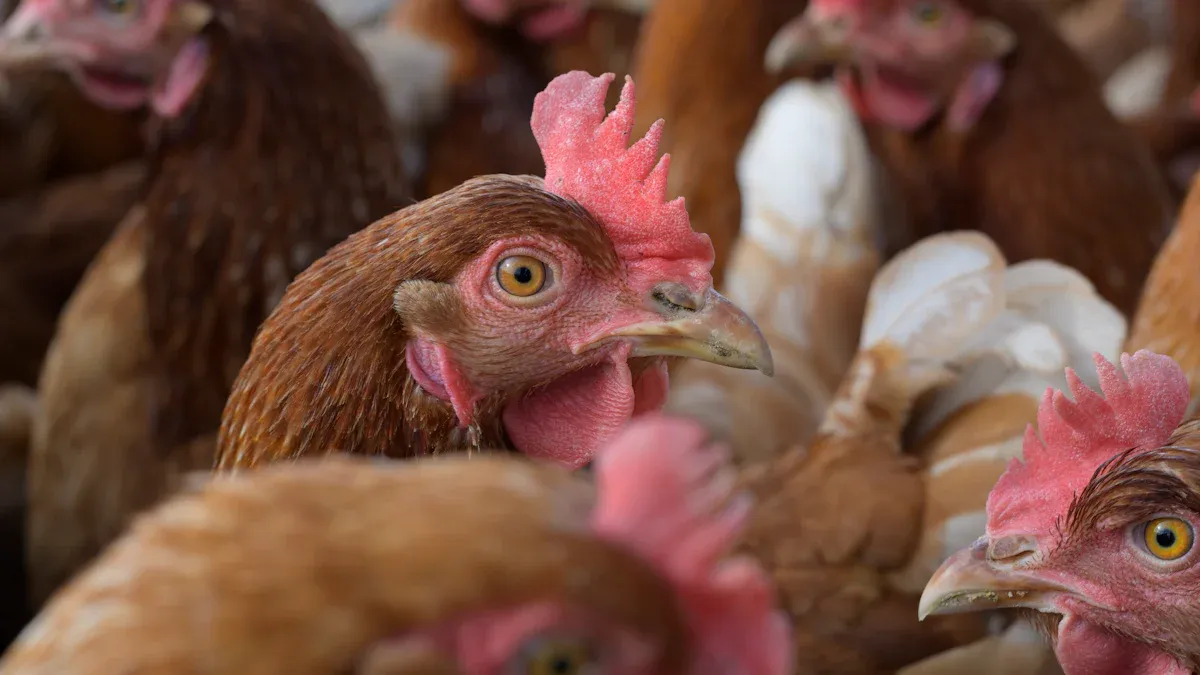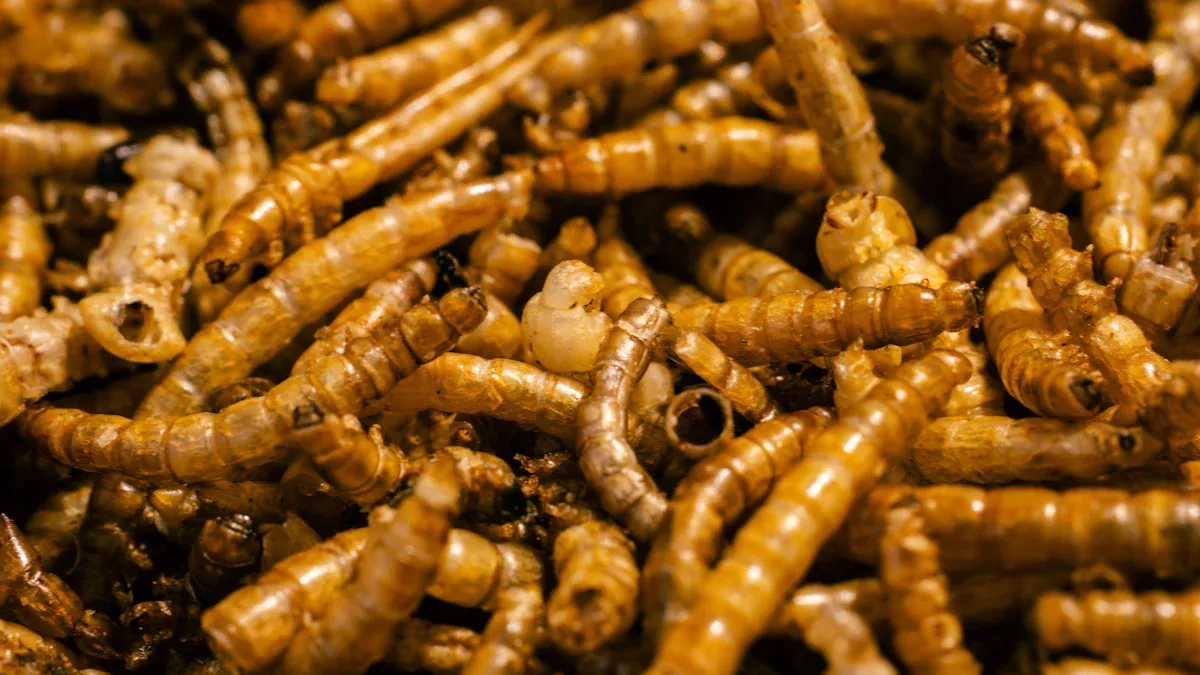
Mealworms as food provide poultry farmers with a game-changing feed option. Packed with protein and essential nutrients, mealworms boost poultry health and productivity. Studies show that replacing traditional feeds like soy with mealworms as food improves growth rates and feed efficiency. Chickens also benefit from enhanced natural foraging behavior, leading to better egg production and overall well-being.
Key Takeaways
- Mealworms are a great protein source, with 47–60% protein. They help improve poultry health and growth.
- Adding mealworms to poultry food can raise egg production by 2.4%. It also makes eggs better quality and more attractive to buyers.
- Feeding poultry mealworms is good for the environment. It uses less land and water than other protein sources and lowers greenhouse gases.
Nutritional Benefits of Mealworms
High Protein and Amino Acid Content
Mealworms are a powerhouse of protein, containing 47–60% protein and 31–43% lipids. This makes them an excellent energy source for poultry. They also provide essential amino acids, omega-3, and omega-6 fatty acids, which are vital for growth and development.
| Protein Source | Protein Content | Amino Acid Profile Comparison |
|---|---|---|
| Mealworms | Up to 60% | Similar to fishmeal |
| Soybeans | ~44% | Inferior to mealworms |
| Fishmeal | Varies | Comparable to mealworms |
Protein plays a key role in feather development and egg production. By incorporating mealworms into poultry feed, farmers can ensure their chickens receive a high-quality protein source that supports overall health and productivity.
Essential Nutrients for Poultry Health
Mealworms do more than just provide protein. They support the immune system, improve feather quality, and aid digestion. Chickens fed mealworms often maintain a healthy weight and show increased vitality.
Did you know? Mealworms act as a natural immune booster, helping chickens fend off diseases and stay healthier.
Studies show that replacing soybean meal with dried mealworms enhances growth performance and feed efficiency. This makes mealworms a practical and nutritious choice for poultry farmers looking to improve their flock’s health.
Impact on Egg Quality and Flavor
Mealworms as food can significantly enhance egg quality. Their rich fatty acid content improves yolk color, resulting in darker, more vibrant yolks. Eggs from chickens fed mealworms are also nutritionally superior, making them more appealing to consumers.
Farmers have reported a 2.4% increase in egg production when incorporating mealworms into poultry diets. These eggs not only look better but also taste better, offering a richer flavor that stands out in the market.
Improved Feed Conversion and Productivity
How Mealworms Enhance Feed Efficiency
Mealworms are a game-changer when it comes to feed efficiency. They provide a high-quality protein source that poultry can digest easily. This means chickens get more nutrients from every bite, leading to faster growth and better health. Studies show that replacing soybean meal with mealworms improves feed conversion ratios. Broiler chickens, for example, gain weight faster and require less feed to do so.
Here’s a quick look at how mealworms compare across different animals:
| Study Focus | Findings |
|---|---|
| Poultry | Replacing soybean meal with mealworms improves growth and feed efficiency. |
| Fish | Mealworms enhance growth and meat quality by boosting fatty acid profiles. |
| Pigs | Inclusion of mealworms leads to better digestibility and overall health. |
| Toviho & Bársony (2022) | Mealworms provide equivalent or improved growth performance compared to traditional feed sources. |
Cost Savings and Increased Growth Rates
Switching to mealworms as food can save farmers money. Mealworms replace expensive feed ingredients like fishmeal and soybean meal without sacrificing nutritional value. They also improve growth rates, which means farmers can raise healthier birds in less time. Research shows that mealworms enhance meat quality and digestibility, making them a cost-effective choice for poultry farming.
Benefits for Broiler Chickens and Egg-Laying Hens
Broiler chickens thrive on mealworm-based diets. They grow faster, convert feed more efficiently, and produce higher-quality meat. Egg-laying hens also benefit. Mealworms improve egg production by 2.4% and enhance yolk color and flavor. This makes the eggs more appealing to consumers and boosts their market value. Farmers who incorporate mealworms into their feed see healthier flocks and better productivity overall.
Sustainability and Practical Use of Mealworms As Food

Eco-Friendly Farming and Waste Conversion
Mealworms offer a sustainable solution for poultry farming by reducing environmental impact. They require minimal resources to produce, making them an eco-friendly alternative to traditional protein sources.
- Producing 1 kg of mealworm protein uses only 22.38 m² of land, which is just 10% of the land needed for beef production.
- Water consumption is 3.5 times lower than beef, conserving valuable resources.
- Mealworms emit fewer greenhouse gases, such as CO2 and methane, and release less ammonia, improving air quality and reducing pollution.
Additionally, mealworms can convert organic waste into high-quality protein. Farmers can use agricultural byproducts or food waste to feed mealworms, turning waste into a valuable resource. This process not only reduces waste but also supports circular farming practices.
Aligning with Sustainable Agriculture Goals
Using mealworms in poultry feed aligns with global sustainability goals. They contribute to food security and poverty alleviation by providing an affordable and efficient protein source.
| Study Title | Findings |
|---|---|
| Study on mealworms as sustainable protein source | Mealworms can replace traditional protein sources and their waste serves as organic fertilizer. |
Feeding chickens with mealworms enhances the livelihoods of small-scale farmers. It reduces reliance on expensive feed ingredients like soybean meal and fishmeal, lowering costs and increasing income. This approach also promotes gender equality by empowering women in farming communities to adopt innovative practices.
Sourcing and Incorporating Mealworms in Poultry Feed
Farmers can source yellow mealworms from specialized insect farms or grow them on-site. Research shows that mealworms provide comparable nutritional value to soybean meal, offering essential amino acids, fatty acids, and micronutrients. Incorporating mealworms into poultry feed improves sustainability and reduces greenhouse gas emissions.
Younger farmers are more likely to adopt mealworms as feed due to their openness to innovation. Educating farmers about the benefits of mealworms can increase their acceptance and adoption. By embracing mealworms as food, poultry farmers can create a more sustainable and cost-effective feeding system.
Mealworms offer poultry farmers a sustainable and cost-effective feed solution. They pack 47–60% protein and 31–43% lipids, providing essential nutrients for poultry health.
- Producing 1 kg of mealworm protein uses just 22.38 m² of land, 10% of what beef requires.
- Water usage is 3.5 times lower than beef production.
Farmers can boost egg production by 2.4% while reducing costs and environmental impact. Mealworms are a practical choice for eco-friendly farming.
FAQ
What makes mealworms better than traditional poultry feed?
Mealworms provide more protein and essential nutrients than soybean meal. They’re easier to digest and help chickens grow faster while improving egg quality.
Are mealworms safe for chickens to eat?
Yes! Mealworms are completely safe and natural for chickens. They even boost immunity and improve overall health.
How can farmers start using mealworms in poultry feed?
Farmers can buy dried mealworms from suppliers or raise them on-site. Mixing them with regular feed is an easy way to get started.


